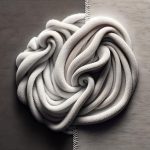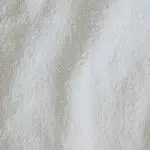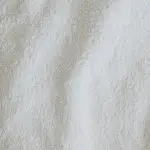You may be familiar with French terry fabric, but have you ever wondered about its composition?
Exploring French Terry: What Is It Made Of provides you with an in-depth understanding of the materials that make up this versatile textile.
From the origins of French terry to the role of cotton, polyester, and spandex, this exploration delves into the intricate details that contribute to the fabric's unique properties.
By delving into the composition of French terry, you will gain mastery over the intricacies of its fibers, blending techniques, and environmental impact.
Whether you are a textile enthusiast, designer, or simply curious about the fabric you wear, this exploration will provide you with the knowledge you seek.
Key Takeaways
- French Terry is primarily composed of cotton, with some variations including a blend of cotton and synthetic fibers.
- Polyester is used in French Terry to enhance its moisture-wicking capabilities, promote breathability, and provide resistance to stretching, shrinking, and wrinkling.
- The addition of spandex in French Terry contributes to flexibility, durability, and improved stretch and recovery of the fabric, making it a popular choice for performance wear and athletic clothing.
- Blending cotton with polyester in French Terry improves its durability, moisture-wicking properties, and ease of care, while the use of organic cotton or recycled materials and choosing brands with ethical and transparent supply chains can contribute to a more eco-friendly production process.
The Origins of French Terry
The origins of French Terry can be traced back to the early 19th century when it was first developed as a versatile and comfortable fabric for various clothing applications. Its historical significance lies in its evolution from traditional terry cloth, with the French Terry fabric being distinguished by its unbrushed looped back and smooth face. This unique construction provides enhanced breathability and moisture-wicking properties, making it an ideal choice for activewear and casual garments.
The manufacturing process of French Terry involves the use of knitting machines to create loops on one side of the fabric, while the other side remains flat. This results in a highly absorbent material that's also lightweight and insulating. The fabric production typically starts with quality raw materials such as cotton, polyester, or a blend of both, which are then knitted and dyed to achieve the desired colors and patterns.
Understanding the origins and manufacturing process of French Terry provides insight into its popularity and widespread use in the fashion industry today. Whether you're looking for comfortable loungewear or durable sportswear, French Terry continues to be a go-to fabric for its combination of functionality and style.
Understanding the Composition
Now let's take a closer look at the composition of French terry fabric. Understanding the components and composition of this versatile material will provide you with valuable insight into its quality and performance.
Let's explore what makes French terry such a popular choice in the world of textiles.
French Terry Fabric Components
To understand the composition of French Terry fabric, you need to examine its specific components and their properties. French Terry fabric consists of various components that contribute to its unique properties. Here's what makes up this versatile fabric:
- Fabric Construction: French Terry is typically made of cotton, sometimes blended with polyester or spandex. The construction involves uncut loops on one side and soft piles of yarn on the other, creating a lightweight yet insulating fabric.
- Moisture Wicking Properties: The fabric's composition allows it to efficiently absorb moisture from the skin and wick it away, keeping you dry and comfortable during physical activities.
- Durability: The combination of fibers and fabric construction makes French Terry durable and long-lasting, suitable for various types of clothing.
- Breathability: The composition of French Terry allows for excellent breathability, making it suitable for both warm and cool weather.
Composition of French Terry
Are you curious about what materials make up French Terry fabric?
French Terry is primarily composed of cotton, with some variations including a blend of cotton and synthetic fibers like polyester or elastane.
The fabric construction of French Terry involves uncut loops on one side and a soft, brushed underside, which contributes to its unique texture and comfort.
Understanding the composition of French Terry is crucial in appreciating its quality and performance.
The textile history of French Terry reveals its origins in the 19th century, where it was initially used for sportswear due to its moisture-wicking properties.
Over time, it has evolved into a versatile fabric used in various clothing items, from casual wear to activewear.
Knowing the composition and fabric construction of French Terry enhances your understanding of its durability and versatility.
The Role of Cotton in French Terry
Cotton plays a crucial role in the production of French Terry, as it's the primary fiber used to create this versatile fabric. It brings several advantages to the table, making it an essential component in the creation of French Terry:
- Breathability: Cotton's natural breathability makes French Terry a comfortable and airy fabric, perfect for a wide range of clothing items, from cozy loungewear to lightweight jackets.
- Moisture Absorption: Cotton has excellent moisture-wicking properties, making French Terry a great choice for activewear and athleisure, as it helps to keep the skin dry and comfortable during physical activities.
- Textile Production: Cotton is a widely available natural fiber, making it an accessible and sustainable choice for the production of French Terry. Its versatility and ease of blending with other fibers make it a favorite among textile manufacturers.
- Cotton Benefits: French Terry made with cotton is soft, durable, and easy to care for, offering a great balance of comfort and practicality.
Understanding the important role that cotton plays in the creation of French Terry sheds light on the fabric's exceptional qualities and its widespread popularity in the fashion industry.
Exploring Polyester's Contribution
The role of polyester in French Terry fabric production is significant due to its unique properties and versatile applications in textile manufacturing. Polyester offers several benefits that make it an essential component of French Terry. Its moisture-wicking capabilities help to draw sweat away from the skin, keeping you dry and comfortable during physical activities. This feature is especially useful for sportswear and activewear, as it promotes breathability and prevents the fabric from sticking to the skin. Additionally, polyester is known for its durability, making it resistant to stretching, shrinking, and wrinkling. These qualities contribute to the longevity of French Terry garments, reducing the frequency of replacement and overall environmental impact.
While polyester has been criticized for its environmental impact, advancements in technology have led to the development of recycled polyester, which helps to mitigate its carbon footprint. By incorporating recycled polyester into French Terry production, the environmental impact can be minimized, offering a more sustainable option for consumers.
Delving Into Spandex Content
Now let's take a closer look at the spandex content of French terry fabric.
Spandex is known for its stretchy properties, which contribute to the overall flexibility and durability of the fabric.
Understanding the spandex content in French terry can provide insights into the comfort and performance of garments made from this material.
Stretchy Fabric Properties
When working with French terry, you'll notice the stretchy fabric properties due to its spandex content. This unique feature makes it a popular choice in performance wear and athletic clothing, providing comfort and flexibility for active individuals. The addition of spandex enhances the overall stretch and recovery of the fabric, making it an ideal choice for garments that require ease of movement.
- Enhanced Flexibility: The spandex content in French terry allows for increased stretch, offering freedom of movement during various activities.
- Improved Comfort: Spandex helps the fabric conform to your body, providing a comfortable and snug fit without restricting movement.
- Great Shape Retention: The inclusion of spandex ensures that the fabric maintains its shape and structure, even after repeated wear and washing.
- Versatile Applications: The stretchy properties of French terry with spandex make it suitable for a wide range of clothing items, including activewear, loungewear, and casual apparel.
Durability and Flexibility
How does the spandex content in French terry contribute to its durability and flexibility for various activities?
The addition of spandex to French terry enhances its durability and flexibility, making it ideal for a wide range of activities. Durability testing has shown that spandex increases the fabric's ability to withstand wear and tear, making it suitable for high-intensity workouts and everyday wear.
The spandex content also provides excellent fabric flexibility, allowing for unrestricted movement during physical activities such as yoga, running, or weightlifting. This means that your French terry garments will maintain their shape and elasticity, even after frequent use and washing.
With the incorporation of spandex, French terry offers both durability and flexibility, making it a versatile and long-lasting fabric for various active lifestyles.
Comfort and Performance
With the inclusion of spandex, French terry provides a comfortable and high-performance fabric for various activities, ensuring durability and flexibility for your active lifestyle. The comfort and performance of French terry with spandex are attributed to its unique fabric technology, making it an ideal choice for those who prioritize both comfort and functionality. Here's why it's a game-changer:
- Unparalleled Comfort: The spandex content in French terry allows for a comfortable design that moves with your body, providing a snug yet non-restrictive fit.
- Enhanced Flexibility: The addition of spandex ensures that the fabric stretches and recovers well, offering optimum flexibility during movement.
- Moisture Management: Spandex helps in wicking away moisture, keeping you dry and comfortable during intense activities.
- Long-lasting Performance: The spandex blend contributes to the fabric's resilience, ensuring long-lasting performance wash after wash.
Other Fibers in French Terry
You will find various other fibers woven into French terry to enhance its texture and performance. In addition to the main cotton component, polyester is often blended into French terry to add durability, moisture-wicking properties, and color retention. This synthetic fiber helps the fabric maintain its shape and resist wrinkles, making it ideal for athletic and casual wear. Polyester also enhances the overall strength and longevity of the garment, ensuring that your French terry clothing lasts through numerous washes and wears.
Another common addition to French terry is spandex, which provides elasticity and stretch. This allows the fabric to comfortably conform to your body's movements, offering flexibility and freedom of movement. The inclusion of spandex in French terry garments ensures a comfortable and accommodating fit, making it suitable for various activities such as yoga, running, or simply lounging.
The combination of spandex with cotton and polyester creates a versatile fabric that not only feels great against the skin but also provides the necessary support for an active lifestyle.
Blending Techniques and Effects
Blending cotton with polyester and spandex creates French terry with enhanced durability, flexibility, and performance. Blending techniques play a crucial role in the fabric construction process, allowing for the creation of textiles that offer a unique blend of properties.
Here's what you need to know about blending techniques and their effects:
- Improved Durability: Blending cotton with polyester enhances the fabric's strength and resistance to wear and tear, making it more durable for everyday use.
- Enhanced Flexibility: The addition of spandex to the blend provides French terry with increased stretch and flexibility, allowing for greater freedom of movement.
- Moisture Management: Blending cotton with polyester helps wick moisture away from the body, keeping you dry and comfortable during physical activities.
- Wrinkle Resistance: The combination of cotton and polyester results in a fabric that's less prone to wrinkling, making it easier to care for and maintain its appearance.
Understanding blending techniques and their effects on fabric construction can help you make informed decisions when selecting French terry garments that best suit your needs.
Evaluating Environmental Impact
Assessing the environmental impact of French terry production involves examining the sourcing, manufacturing, and disposal processes to understand its sustainability.
When evaluating the environmental impact of French terry, it's essential to consider the materials used in its production. Look for sustainable practices such as the use of organic cotton or recycled materials, which can significantly reduce the ecological footprint.
Additionally, the manufacturing process plays a crucial role in determining the environmental impact. Look for manufacturers that prioritize energy efficiency, water conservation, and waste reduction. By choosing suppliers with sustainable practices, you can contribute to a more eco-friendly production process.
Furthermore, the disposal of French terry products should be considered. Look for brands that offer recycling programs or biodegradable packaging to minimize environmental impact. Additionally, seek out companies that prioritize ethical and transparent supply chains, ensuring fair labor practices and minimizing harm to communities and ecosystems.
Frequently Asked Questions
How Does French Terry Fabric Compare to Other Types of Knit Fabrics?
When comparing fabric textures, French terry stands out with its unique looped texture that offers excellent stretch and recovery properties. Its softness and absorbency make it a versatile choice for various clothing items.
Are There Any Special Care Instructions for Washing and Drying French Terry Fabric?
For washing and drying French terry fabric, special care instructions are essential. To maintain the fabric's quality, follow these fabric care instructions: wash in cold water, use a gentle cycle, and tumble dry on low heat.
Can French Terry Fabric Be Used for Making Athletic or Activewear?
Yes, French terry fabric can be used for making athletic or activewear. Its moisture-wicking properties and comfortable fit make it an excellent choice for workout attire. It provides both functionality and style for your active lifestyle.
What Are the Different Ways French Terry Fabric Can Be Used in Fashion and Apparel?
When it comes to fabric applications, French terry is incredibly versatile. Its sustainability and soft texture make it perfect for various clothing styles, from cozy loungewear to trendy athleisure. Its versatility in fashion is unmatched.
Are There Any Common Misconceptions About French Terry Fabric That Should Be Addressed?
You may have heard some misconceptions about French Terry, but it's important to know the truth. The fabric composition and breathability properties of French Terry make it a versatile and comfortable choice for various fashion and apparel items.
- Innovations in Moisture-Wicking Textiles - July 18, 2024
- Engineering Fabrics for Optimal Performance - July 18, 2024
- The Science of Breathability in Fabrics - July 18, 2024








